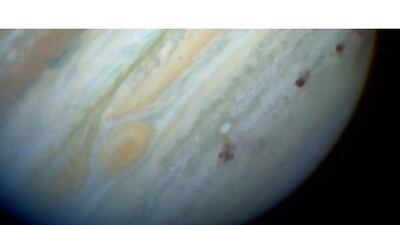Since their discovery in an Egyptian cemetery more than a century ago, a handful of metal beads have perplexed archaeologists.
As jewellery, the beads seem decidedly downmarket, being made of nothing more glamorous than iron. Yet clearly their owner, dead for more than 5,000 years, held them in great esteem - as do Egyptologists, as such objects should not have existed until the emergence of iron smelting in the region thousands of years later.
Now the mystery has reached a heavenly resolution - quite literally. Tests have revealed that the beads originated in deep space.
There have long been suspicions that the metal in the beads came from a meteorite. Earlier studies found traces of nickel along with the iron, typical of meteorites created from the cores of giant asteroids that disintegrated in deep space long ago. But now a team of British researchers has shown that the metal contains crystallisation patterns formed during the slow solidification of molten iron deep inside asteroids.
Publishing its findings in the current issue of the journal Meteoritics and Planetary Science, the team says its tests show that the oldest known iron in Egypt had celestial rather than man-made origins. The results also explain why the owner of the beads deemed the beads so special: they must have seemed to be a gift from heaven.
It is becoming clear that the heavens have sent us all gifts far more precious than fancy jewellery, however. Scientists now think much, if not all, of that life-giving colourless liquid that comes out of our taps may have come from deep space.
The origin of the 1,450 million billion tonnes of water in the world's oceans has long been a mystery. One leading theory is that water molecules were formed from hydrogen and oxygen molecules combining inside the early Earth, and emerging as steam in volcanic eruptions.
But over the years, an alternative explanation has gained weight. Perhaps water molecules were delivered here aboard comets.
Evidence supporting the celestial theory comes from detailed observations of comets, which have turned out to be like fluffy balls of dirty snow, rich in water-ice.
Yet there was a problem: it was unclear that comets could account for the fact that about 0.3 per cent of oceanic water contains an unusual form of hydrogen, called deuterium.
Then in 2011, astronomers found deuterium-based water - known as "heavy water" - on a comet by the name of Hartley 2. And last year, scientists discovered deuterium-based ions in a protein found in simple microbes - linking heavy water to primitive life on Earth.
Astronomers have now confirmed that comets are still capable of delivering huge amounts of water to planets.
In July 1994, a small comet named Shoemaker-Levy 9 came too close to Jupiter and was torn apart, its contents being dumped into the atmosphere over the giant planet's southern hemisphere.
The effect was closely monitored by observatories around the world, among them the European Space Agency's (ESA) orbiting Infrared Space Observatory. This revealed signs of water circulating the giant planet.
What was not clear, however, was whether it had always been there, or had been dumped there by the comet.
Now the ESA's Herschel space observatory has taken a closer look, and confirmed the source of the water. It found there is two to three times more water over the planet's southern hemisphere - and the highest concentrations are where the comet fragments struck. The astronomers estimate that perhaps 95 per cent of water in the stratosphere of Jupiter came from the comet.
With comets now linked to the existence of water on planets, and to primitive life, attention is now focusing on their role in delivering the most precious gift of all: life itself.
The idea that life on the early Earth has its origins elsewhere in deep space has been circulating for centuries. Known as the Panspermia Hypothesis, its popularity has ebbed and flowed as scientists gain and lose confidence in the early Earth being able to give rise to primitive life without outside help.
Experiments based on the conditions thought to have existed on our planet billions of years ago have struggled to produce biological molecules in any quantity. This has prompted some scientists to suggest that perhaps comets delivered complex molecules - and perhaps entire life forms - to Earth billions of years ago, "seeding" our planet.
Later this month, scientists at the Lawrence Livermore National Laboratory (LLNL) in California will publish intriguing evidence that comets may indeed have played a key role in the origin of life on Earth - not by delivering molecules ready-made, but by creating them.
Using supercomputer simulations, Dr Nir Goldman of LLNL and Dr Isaac Tamblyn of the University of Ontario Institute of Technology in Canada have been studying the processes that take place when comets collide with the Earth.
It is clear that the effect triggers violent shock waves that pass through a comet, producing huge increases in pressure and temperature. But according to the research, to be published in the Journal of Physical Chemistry A, these conditions are suitable for the formation of many organic compounds - including the precursors to the molecules of life, such as DNA.
Better yet, the sheer numbers of comets thought to have struck the early Earth means the process could have been at work for ages across our planet.
According to Dr Goldman, comet impacts may have delivered as much as 10 billion tonnes of organic materials to the Earth each year.
For centuries comets were regarded with foreboding, bringing pestilence and ill fortune. More recently they have been linked to mass extinctions of life on Earth. Ironically, it now seems life on Earth may owe its existence to the demise of these icy travellers through the void of space.
Robert Matthews is visiting reader in science at Aston University, Birmingham, England.

